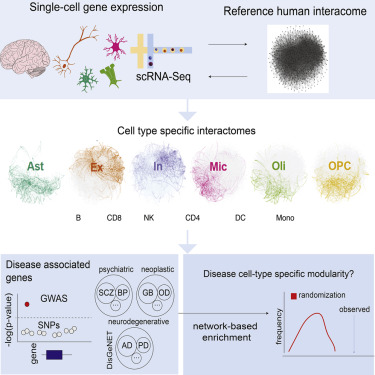Cell Systems ( IF 9.0 ) Pub Date : 2019-11-27 , DOI: 10.1016/j.cels.2019.10.007 Shahin Mohammadi 1 , Jose Davila-Velderrain 1 , Manolis Kellis 1

|
The human interactome is instrumental in the systems-level study of the cell and the contextualization of disease-associated gene perturbations. However, reference organismal interactomes do not capture the cell-type-specific context in which proteins and modules preferentially act. Here, we introduce SCINET, a computational framework that reconstructs an ensemble of cell-type-specific interactomes by integrating a global, context-independent reference interactome with a single-cell gene-expression profile. SCINET addresses technical challenges of single-cell data by robustly imputing, transforming, and normalizing the initially noisy and sparse expression of data. Inferred cell-level gene interaction probabilities and group-level interaction strengths define cell-type-specific interactomes. We use SCINET to reconstruct and analyze interactomes of the major human brain and immune cell types, revealing specificity and modularity of perturbations associated with neurodegenerative, neuropsychiatric, and autoimmune disorders. We report cell-type interactomes for brain and immune cell types, together with the SCINET package.
中文翻译:

以单细胞分辨率重建细胞类型特异性相互作用组。
人类相互作用组在细胞的系统级研究和疾病相关基因扰动的背景化中发挥着重要作用。然而,参考生物体相互作用组并不能捕获蛋白质和模块优先发挥作用的细胞类型特异性背景。在这里,我们介绍 SCINET,这是一个计算框架,通过将全局的、上下文无关的参考相互作用组与单细胞基因表达谱集成来重建细胞类型特异性相互作用组的集合。SCINET 通过稳健地插补、转换和标准化最初嘈杂且稀疏的数据表达来解决单细胞数据的技术挑战。推断的细胞水平基因相互作用概率和群体水平相互作用强度定义了细胞类型特异性相互作用组。我们使用 SCINET 来重建和分析主要人脑和免疫细胞类型的相互作用组,揭示与神经退行性疾病、神经精神疾病和自身免疫性疾病相关的扰动的特异性和模块化。我们报告了大脑和免疫细胞类型的细胞类型相互作用组以及 SCINET 包。











































 京公网安备 11010802027423号
京公网安备 11010802027423号